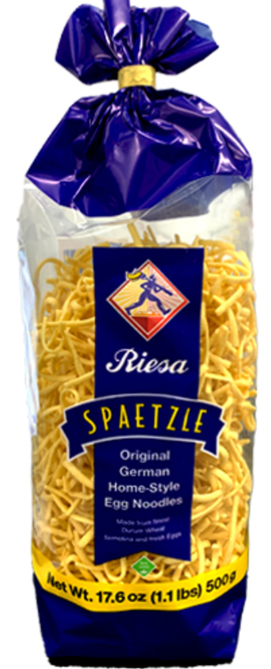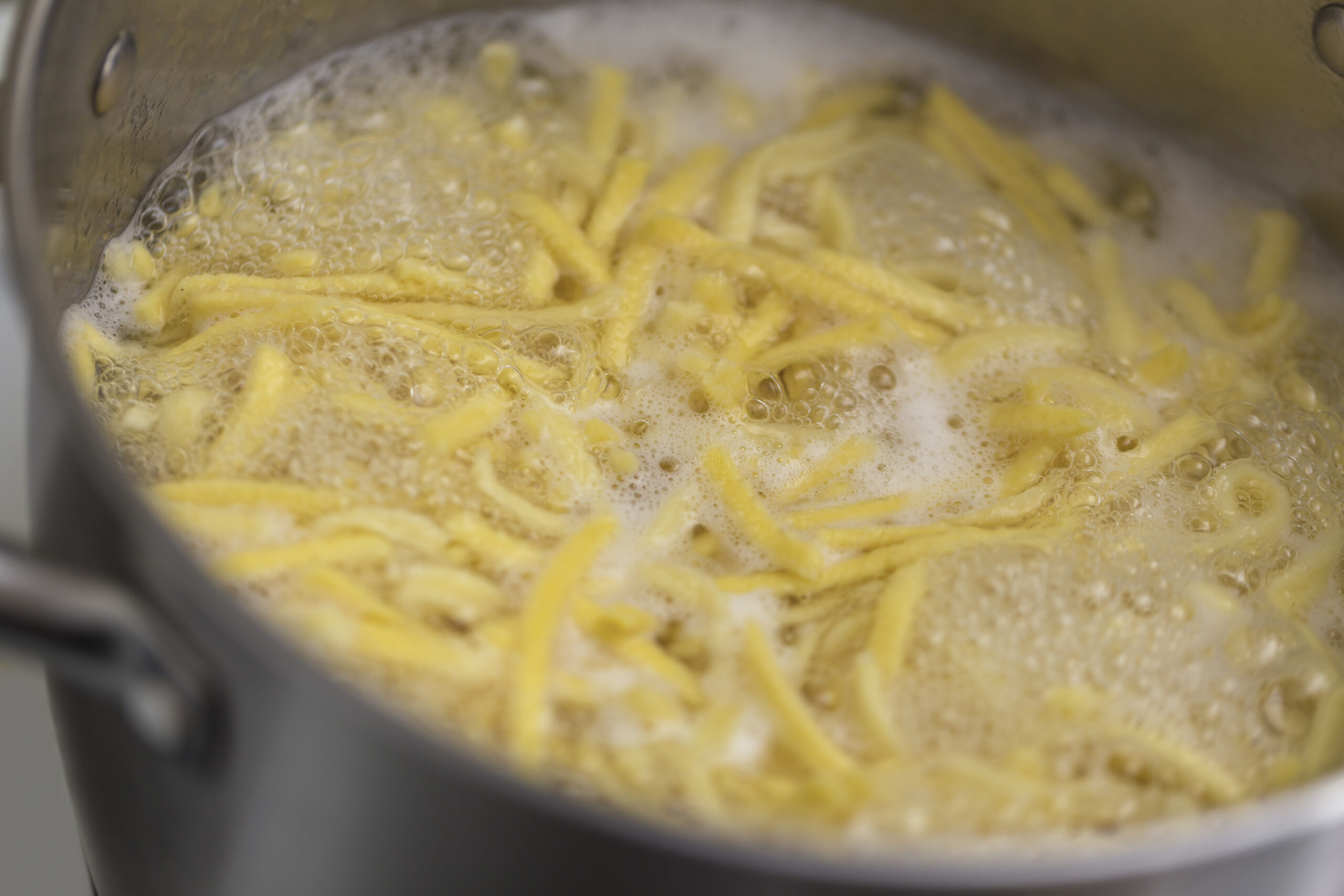 All Culinary Chronicles
All Culinary Chronicles
Oktoberfest and The Origin of Spaetzle
The Draeger Family is deeply rooted in our German heritage. If you haven’t already read the tale, Draeger’s founder, Gustave Draeger, came to America in 1903 from Stettin, Prussia. With him he brought his willingness to work and a potato salad recipe. It is from such simple roots that our ever-epicurious family evolved into the foodies we are today. Oktoberfest as celebrated here in America has become an excuse to drink beer and eat sausage, but the celebration of German heritage is the origin for the two week food and beer extravaganza.
This year, when thinking about Oktoberfest food and beer, I was inspired by the German Festival itself. The food tents in Germany are featuring many different vegetarian options- a fresh take on the typical German Brat. Not that there’s anything wrong with brats! But a different perspective on German cuisine is something that probably isn’t the first thing you think of when the word “Oktoberfest” is spoken.
Spaetzle. Phonetically pronounced: Spat-sl. Spaetzle is essentially the German version of an egg noddle, made with the most basic of ingredients: flour, egg, salt, and water or milk. The word itself comes from the southwestern German dialect of Swabian. ‘Spatz’ means sparrow, thus ‘spaetzle’ translates to ‘little sparrow.’ This makes sense when you see how small the egg noodles are! Interchangeably, they are also referred to in German as ‘knöpfle,’ which means ‘small buttons.’ Again, a very apropos title for the round little noodles.

Spaetzle are known as ‘spatzil’ in Switzerland, Chnöpfli in Hungry, and the Slovakians have three other names for the noodles: Nokedli, Csipetke or Galuska. In fact, there are several more names given through Eastern Europe for these delicate little guys, which leads me to think about what an impact these simple noodles have had on other cultures, not just Germanic.
Why? Why would such a small way of preparing and cooking a food spread through such a large area, and become so well known? Though the origin of spaetzle is traced back to medieval times through depictions in art, a personal physician from Württemberg, Germany named Rosino Lentilio concluded in 1725 that ‘spazen’ and ‘knöpflein’ were “all the things made from flour.” Given that flour of any grain was the basis for the European diet, the similar springing up of recipes in multiple European countries makes sense.
Spelt was cultivated by the 9th century across Germany, northern France, parts of Switzerland, and Tyrol thanks to its adaptable nature in cold climates, as well as its superior storage quality. The farmers who grew the grains in Germany came from a poor rural area, and the rich in gluten protein spaetzle was easy to make, even in the hardest of economic times. Thus, the simple egg noodle recipe, with all of its different names, sprung up as a coveted food all over Eastern Europe.

 Just as lobster in America, which was once considered ‘the poor man’s protein,’ spaetzle slowly made a transition from simple farmer food to a culinary specialty made for feast days. Today, spaetzle is still considered a ‘Swabian specialty.’ Germany alone exports an estimated 40,000 tons of spaetzle internationally each year. Swabian spaetzle and knöpfle have been granted a PGI “Protected Geographical Indication,” in much the same way wines can have a designated origin or region. Whew! A whirlwind of history which tells the origin story of a food most Americans have never heard of, yet one that not only shaped German culture, but many other countries as it evolved.
Just as lobster in America, which was once considered ‘the poor man’s protein,’ spaetzle slowly made a transition from simple farmer food to a culinary specialty made for feast days. Today, spaetzle is still considered a ‘Swabian specialty.’ Germany alone exports an estimated 40,000 tons of spaetzle internationally each year. Swabian spaetzle and knöpfle have been granted a PGI “Protected Geographical Indication,” in much the same way wines can have a designated origin or region. Whew! A whirlwind of history which tells the origin story of a food most Americans have never heard of, yet one that not only shaped German culture, but many other countries as it evolved.

Traditionally, spaetzle dough consists of the few ingredients a farmer would have had on hand: eggs, flour, and salt. The Swabian rule of thumb is to use a number of eggs equal to the number of flour servings, plus one. Water or milk can be added to produce a runnier dough that is then made into noodles by scraping the dough against a special grater or colander into boiling salted water. The small round noodles cook until they pop to the surface. The noodles can be used as the base to a dish, or an addition to a dish depending on the culture the recipe originated from. For example, in Germany Käsespätzle is spaetzle made with melted cheese (most often Emmental cheese), and fried onions (mmm, sounds to me like a new version of Mac and Cheese to try!); where as in Hungary nokedli (spaetzle) are served as a side dish for Chicken Paprikash, or are added to soup. Look no further for a recipe to make your own spaetzle than right here!
Make Your Own Spaetzle
- Difficulty: Intermediate
- Prep Time: 5 min
- Cook Time: 50 min
- Serves: 4-6
- Attribute: Draeger’s Markets
Ingredients
- 2 cups spelt flour, 00 flour, or all-purpose bread flour
- 1 tbsp + 2 tsp salt, separated
- 4 large eggs
- ¾ cup milk or water
Directions
- Using a mixer or mixing bowl, whisk together vigorously your chosen flour, eggs, milk (or water), and 2 tsp of salt until the batter is well combined and develops bubbles. Once the batter has been mixed, let it rest for a minimum of 30 minutes. It should feel thick and sticky when ready to cook.
- Fill a large pot with water and begin to bring it to a boil, adding the 1 tbsp of salt to the water. Once boiling, turn the water down to a simmer.
- Set yourself up for success beginning by placing a colander over a bowl to drain the spaetzle once cooked.
- Press a small batch of batter through a spaetzle maker or colander into the simmering water. Work in batches to allow the noodles to cook through thoroughly and prevent them from sticking to each other.
- Let each batch of dough cook for 2-3 minutes, until they float to the top. Stir occasionally, and when done use a slotted spoon to transfer the spaetzle to the waiting colander to let excess water drip off.
- Use in a recipe or serve as is, garnish with parsley if desired.